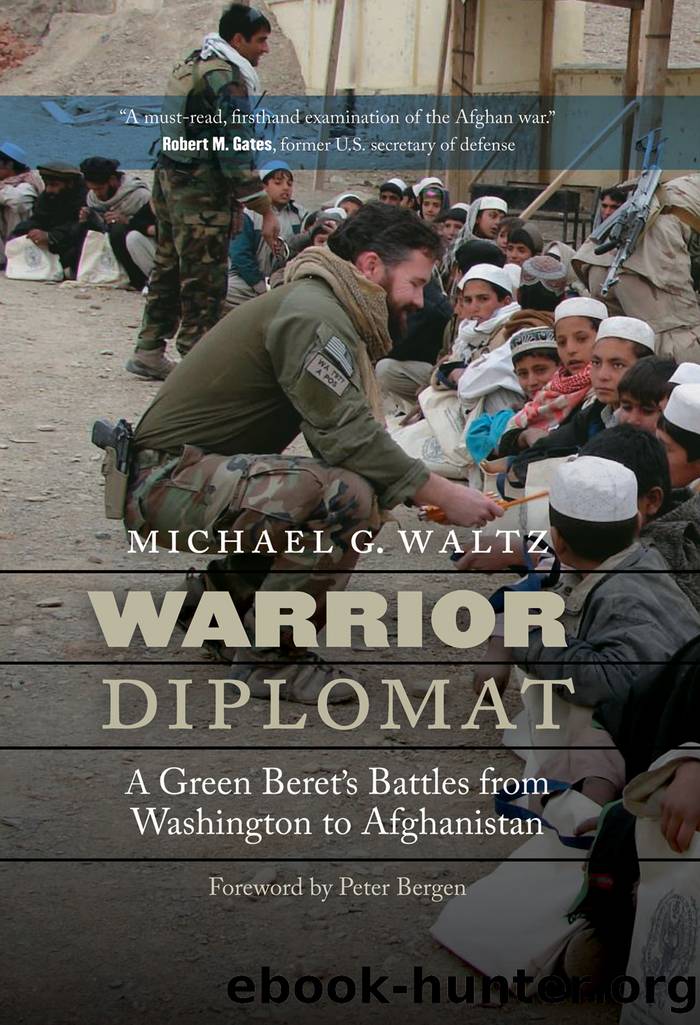Warrior Diplomat by Michael G. Waltz

Author:Michael G. Waltz
Language: eng
Format: epub
Publisher: Potomac Books
Published: 2014-08-15T00:00:00+00:00
8 Back to Washington
The Pentagon and the White House
In late 2006 I was back in coat and tie at the Pentagon, having been asked to serve as a country director for Afghanistan in the Middle East bureau of the Office of the Secretary of Defense-Policy. I was pleased to find some growing awareness in OSD-Policy of the worsening situation in Afghanistan. However, I also found many of my colleagues increasingly frustrated. Even though our senior leaders recognized the growing problem, the default response was to turn to the Europeans to do more. Washington and the Pentagon were in the depths of the debate over Iraqânamely whether to get our forces completely out or to double down on the war with a surge in troop levels. With Afghanistan we had basically outsourced the war to NATO in order to focus our resources on Iraq.
Still I would spend the next two years in the Pentagon and the White House trying to convince our policymakers that the situation in Afghanistan had taken a turn for the worse and that our European NATO allies were in over their heads despite the brave efforts of their soldiers. I was also determined to make the case that U.S. participation in the war was rudderless, that Pakistan had made a strategic shift against our interests, that Afghan governance was often doing more harm than good, and as a result the United States needed to devote significantly more resources to stabilize the situation. The issue of resources was the crux of the matter. Even if Secretary Rumsfeld, our military commanders, and the White House had fully appreciated the extent of the worsening situation, the prevailing feeling in policy circles was that there was little we could do about it. If Afghanistan needed more international support, NATO would have to provide it. With Iraq dragging on much longer than anticipated and massively straining our military, few wanted to even contemplate having to add more U.S. troops to an effort believed to be already won. Afghanistan needed to remain a success story for the administration.
The departure of Donald Rumsfeld and the arrival of Robert Gates as defense secretary in late 2006 brought an opportunity for new thinking on Afghanistan. The term counterinsurgency was controversial in Rumsfeldâs Pentagon for a number of reasons, primarily because doctrinally it required significantly more troops and resources to properly execute a counterinsurgency campaign. This was particularly the case in a place as isolated and difficult as Afghanistan. When Gates came on board we immediately sensed a shift toward openness to more troops for Afghanistan. I accompanied Secretary Gates as part of his delegation on his first trip to see the war, in January 2007. The various commanders he visited stressed the tremendous surge in violence during the previous fighting season and NATOâS struggle to meet its commitments. They also lamented the peace deal the Pakistani government had recently signed with insurgent groups in their Federally Administered Tribal Areas, which created a huge problem for NATOâS efforts in Afghanistan.
Download
This site does not store any files on its server. We only index and link to content provided by other sites. Please contact the content providers to delete copyright contents if any and email us, we'll remove relevant links or contents immediately.
Waking Up in Heaven: A True Story of Brokenness, Heaven, and Life Again by McVea Crystal & Tresniowski Alex(37594)
Empire of the Sikhs by Patwant Singh(22873)
We're Going to Need More Wine by Gabrielle Union(18852)
Hans Sturm: A Soldier's Odyssey on the Eastern Front by Gordon Williamson(18406)
Leonardo da Vinci by Walter Isaacson(13041)
The Radium Girls by Kate Moore(11824)
Tools of Titans by Timothy Ferriss(8095)
Educated by Tara Westover(7848)
How to Be a Bawse: A Guide to Conquering Life by Lilly Singh(7307)
Permanent Record by Edward Snowden(5647)
The Last Black Unicorn by Tiffany Haddish(5512)
The Rise and Fall of Senator Joe McCarthy by James Cross Giblin(5159)
Promise Me, Dad by Joe Biden(5013)
The Wind in My Hair by Masih Alinejad(4977)
A Higher Loyalty: Truth, Lies, and Leadership by James Comey(4743)
The Crown by Robert Lacey(4668)
The Iron Duke by The Iron Duke(4223)
Joan of Arc by Mary Gordon(3945)
Stalin by Stephen Kotkin(3804)
